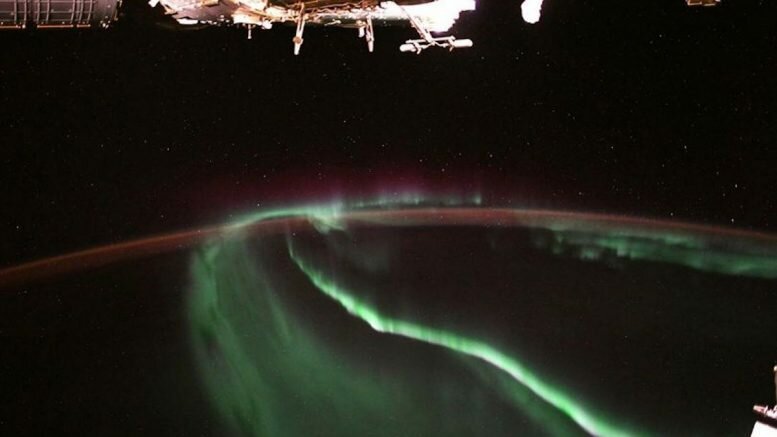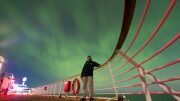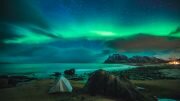How to make Mother Nature’s most magical light show even more fantastic: See it from space.
Read on for a selection of stunning photos and videos of the northern lights from space.
There are few places on Earth to see the auroras with the same spacial effect. But, we’re helping you discover the earthly places that come close – and learn how the auroras are created, too.
What exactly are auroras?
Auroras are created when electrically charged electrons and protons in the Earth’s magnetic field collide with neutral atoms in the upper atmosphere. The color of the lights is produced by gas particles.
The most common color, green, is produced by the collision of oxygen particles in the thermosphere, about 60 miles above the troposphere.
Blue and purplish-red auroras are produced by the collision of nitrogen particles. These particles are found in the exosphere, the highest layer in the earth’s atmosphere, at an altitude of 120,000 miles.
Completely red auroras, the rarest, are produced by high-altitude oxygen, at 200 miles above.
In addition, the Earth’s tilted axis (at about 23.5 degrees) gives way to the phenomena that are the auroras by providing seasons. After all, they would be invisible to the human eye were it not for the backdrop of a dark sky (which, high up north, can last all winter).
The northern lights from space
Brilliant opportunities to view the auroras are offered by astronauts who record them from outer space. NASA has released multiple showings of both the northern lights (aurora borealis) and southern lights (aurora australis).
These glimpses provide insights as to how the celestial spectacle is seen aboard the International Space Station (ISS).
Other pictures and videos taken by space-traversing machinery have made clear that most low-orbit satellites fly actually through the aurora. These bursts of solar particles are truly enormous – they’re pretty tough to miss.
When astronauts are catapulted from the Earth’s atmosphere to outer space, they also sometimes pass through red aurorae. Unfortunately, the rosy lights in particular are usually too faint to be seen by the naked eye.
See for yourself: Photos and videos
Channel your inner astronaut. Here’s our selection of out-of-this-world (literally and figuratively) photos and videos of the aurora borealis.
Norway’s best aurora viewpoints
Not planning on visiting the International Space Station soon? If you can’t view the northern lights from space, here’s where to view them from the next-best place: Norway.
Tromsø
Known as the gateway to the Arctic due in-part to its location in the auroral oval, Tromsø (and its surroundings) provides some of the best chances to see the northern lights.
Tromsø chases after the auroras in style. Residents and visitors often gather in the city center and then drive, boat, or dog sled out of the city to find the best viewpoint.
The North Cape
At the North Cape, you’re surrounded by natural beauty as far as the eye can see. The North Cape is made up of a mountainous plateau which includes a gaping, 307-meter-high cliff that plunges into the Barents Sea.
Aurora hunting season lasts from September to April here. But you may want to visit during the warmer month on the edge of the aurora season. This way, you avoid the cold(est) weather and roughest driving conditions.
It’s usually easy to reach the cape on a self-driving tour due to an underwater tunnel connecting the island of Magerøya to the mainland. Unfortunately, the plateau is tough to reach during the winter as it’s closed and can only be accessed by organized tours.
Lofoten and Vesterålen
Whar distinguishes the Lofoten Islands from the hundreds of other (still beautiful) spots in Norway to see the aurora borealis? Here, the reflections of the lights flicker in the sea, amplifying the wonder of the experience.
Similar to Tromsø, the Lofoten Islands’ proximity to the auroral oval makes viewing the northern lights that much better.
Just north of the Lofoten Islands lies the archipelago of Vesterålen. The area is one of the best in northern Norway to view aurora borealis – and locals can attest to that.
On a northern light safari, expert guides can show you the best viewpoints and teach you how to capture the sights on camera – it can get tricky to catch the elusive sky dancers.
Bodø and Salten
Bodø and Salten’s excellent, year-round light conditions fuel the intensity of the northern lights during their winter season, from September to April.
In Bodø, grab a spot on a rooftop bar or take an organized bus tour to a more secluded area for maximum effect.
Two hours away awaits another incredible hub for the auroras, Salten. This low-key district purposefully offers little traffic and minimal light pollution in order for the northern lights to truly be the center of attention.
What about the southern lights?
We’d be remiss if we didn’t mention the northern lights’ southern counterparts.
Aurora australis, otherwise known as the southern lights, are the southern counterpart of aurora borealis. Similarly to their northern neighbor, the lights are strongest in the southern pole’s oval.
Antarctica takes the cake as the best place to witness southern lights. The continent sits directly inside the southern auroral oval.
Other top spots (which are much more accessible) include New Zealand, Tasmania and Southern Australia, the southern parts of Chile and Argentina, and South Africa, on occasion.
Where to see the southern lights
New Zealand
Visiting New Zealand’s South Island is a must for aurora australis chasers.
Located here, the Aoraki Mackenzie International Dark Sky Reserve is the largest dark sky reserve in the world.
Cockle Creek, Tasmania
Tasmania is one of the only places in the world you can spot auroras almost year-round, thanks to its 41st latitude south and moderate levels of daylight.
Cockle Creek, located just two hours from Hobart, the capital of Tasmania, hosts campgrounds, a national park, and indoor accommodation, all blanketed under dark skies and shimmering auroras.
For a workout, you can hike to the top of Mount John, near Lake Tekapo. Atop Mount John shines the Mount John Observatory, featuring one of the largest telescopes in New Zealand.
Aoraki Mount Cook National Park, also located right within the reserve, boasts a highly pollution-free environment.
Ushuaia, Argentina
Visit Ushuaia and you’ll likely be able to brag about seeing the aurora australis view in the southernmost city in the world.
While it’s oftentimes treated as a pit stop for visitors en route to Antarctica, locals know it’s a well-worthy stargazing station. The best views a bit out of town where light pollution is non-existent. Any dark street, park, or bar in town will do, too.
Once the light show starts, it’ll be impossible to look at anything else, anyway.
South Africa
Catching even a glimpse of the electromagnetic storms in South Africa is quite rare, but not impossible.
A three-hour light show once took place in Cape Town, with blasts of the sky storm seen as far north as Calvinia, South Africa.
The lights are more common off of the South African mainland, for example; on the Prince Edward Islands, which are located about 1100 miles from Port Elizabeth.
Space tourism is unlikely to become widespread in the near future. So, in the meantime, we can indulge in our (arguably just as stunning, just in a different way) earthly views of the auroras.
Source: Norway Today





Be the first to comment on "Awe-striking photos and videos: Behold the northern lights from space"